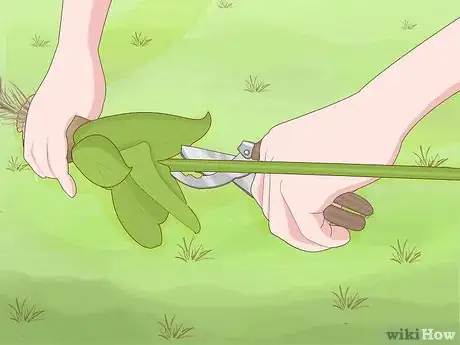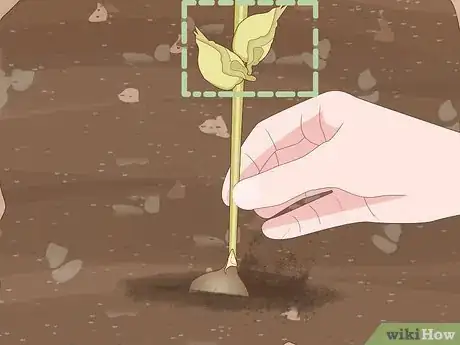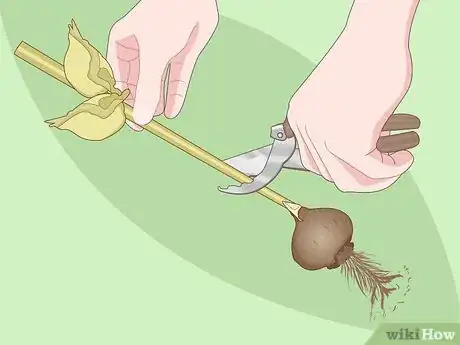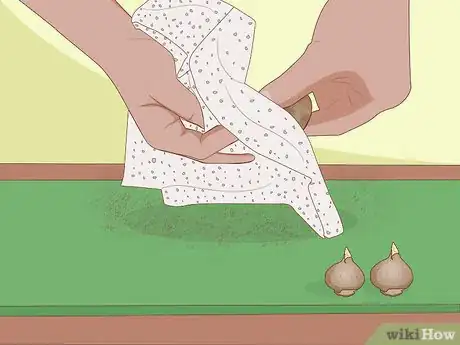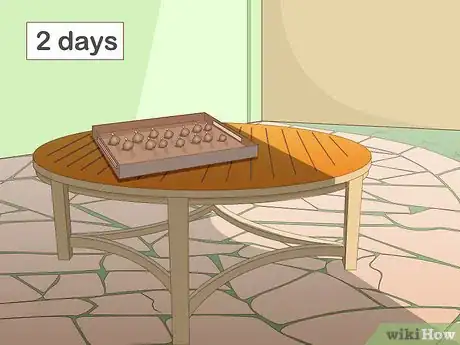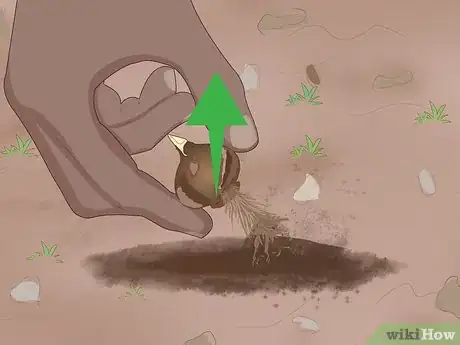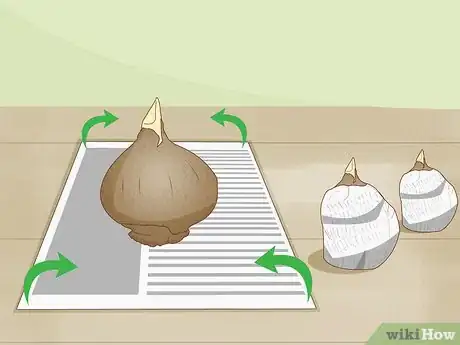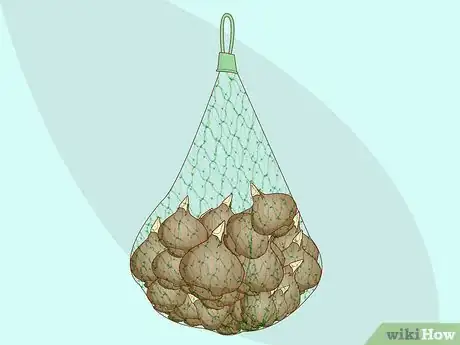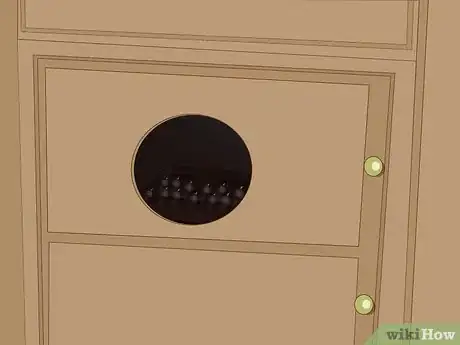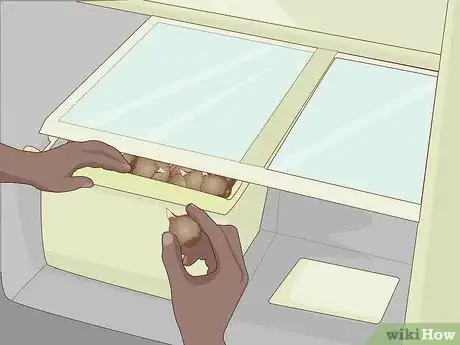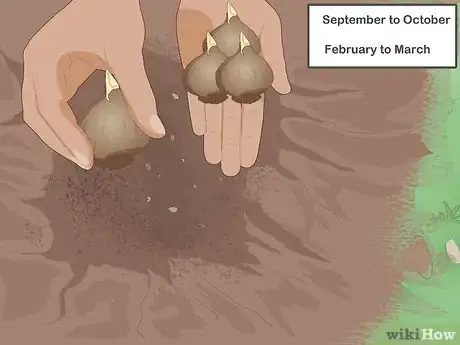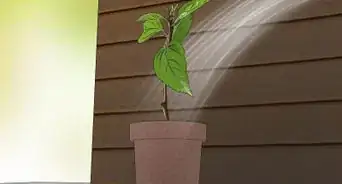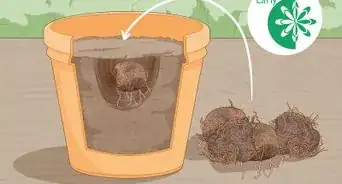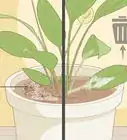This article was co-authored by Lauren Kurtz and by wikiHow staff writer, Hunter Rising. Lauren Kurtz is a Naturalist and Horticultural Specialist. Lauren has worked for Aurora, Colorado managing the Water-Wise Garden at Aurora Municipal Center for the Water Conservation Department. She earned a BA in Environmental and Sustainability Studies from Western Michigan University in 2014.
There are 10 references cited in this article, which can be found at the bottom of the page.
wikiHow marks an article as reader-approved once it receives enough positive feedback. This article received 28 testimonials and 96% of readers who voted found it helpful, earning it our reader-approved status.
This article has been viewed 526,670 times.
Tulips are hearty flowers that bloom in full force in the springtime. Most times, tulips are best when their bulbs are left in the ground year round, but your climate may not cooperate. If you live in an area with warm winters or you bought bulbs in the spring, you may have to store your bulbs so they’re ready to bloom next season.
Steps
Removing the Bulbs
-
1Cut the stems off the bulb with pruning shears after the flower dies. Once your flower has lost its flowers, use a pair of pruning shears to cut the flowering stem off the bulb. This helps prevent the bulb from using more energy than it needs to. Trim as close to the base of the bulb as you can.[1]
- Keep the leaves on your tulips. These help store energy for the next season.
-
2Pull bulbs once the leaves yellow and die. After its blooming period, the leaves of your tulip will take about 6 weeks to yellow and die. In this time, the bulb is gathering the energy it needs from the sun in order to bloom in the next spring season. Once all the leaves have died, you can dig the bulb from the ground or pot.[2]
- Do not overwater the bulbs as the leaves die. An occasional rain is okay, but if the soil is too wet, the bulbs will start to rot.
- Loosen the soil around the bulb with a garden shovel and pull the bulb out of the ground.[3]
Advertisement -
3Remove the leaves and roots at the base of the bulb. The leaves should be easy to remove by hand since they have died. Otherwise, use a pair of pruning shears or sharp scissors to cut off the leaves and the roots. Cut as close to the bulb as you can without damaging it.[4]
-
4Clean the dirt off the bulbs with a paper towel. Wipe the outer layer of the bulbs with a dry paper towel. Remove any soil or worms that may be present. This also helps the bulbs dry faster.[5]
- The outer layer of the bulb may be dying if it is browned or shows signs of rot, so gently rub it with the paper towel in order to remove it.
-
5Dry the bulbs on a tray in a cool, dry place for 2 days. Keep the bulbs in a dry place out of the sun for 2 days. Storing the tray inside your garage or a shaded area outside will work the best.[6]
- If bulbs are stored in the sun or in moist conditions, the bulb will retain the moisture and develop rot.
-
6Throw away any discolored or diseased bulbs. Sort through the bulbs you’ve collected and check for any discoloration that would suggest rot or disease. Tulip bulbs should look full and hard rather than being soft and shriveled.[7]
- Small spots of rot may be removed with a sharp knife sterilized with household disinfectants, such as diluted bleach, rubbing alcohol, or white vinegar.
Storing Bulbs Properly
-
1
-
2Place the bulbs in a mesh bag. A mesh bag allows air to flow to the bulbs while they are being stored. You can reuse an old onion bag rather than purchasing a new mesh bag.[10]
- Alternatively, you can use a paper bag or a cardboard box to keep the bulbs out of the light.
-
3Keep the bulbs in a dark, dry place for up to 12 weeks. A garage or cellar are perfect spots to store the bulbs, as long as the temperatures do not drop below freezing. Keep the bulbs away from light or else they will prematurely start to grow.[11]
-
4Store the bulbs in the crisper drawer of a fridge if you live in a warm climate. If the temperatures do not drop below 50 °F (10 °C), you may have to chill the bulbs in a refrigerator. Keep the bulbs in the crisper drawer so the fridge light does not shine on them.[12]
- Avoid storing tulip bulbs with apples or other fruits since they release ethylene gas that could kill the flower inside the bulb.
-
5Check for any shriveled or moldy bulbs every 2 weeks. Keep an eye on your bulbs while you store them. If the newspapers or your storage materials are rotten or moldy, remove and replace them.[13]
- If the bulbs look wrinkled or shrunken from before, use a spray bottle to gently mist them.
-
6Plant the bulbs in fall before the first frost. Tulips are usually planted 6 to 8 weeks before the first frost, but can be planted in the early spring in time for them to bloom. Plant the bulbs in September or October if you have cold winters. If you need to chill your bulbs, plant them in late February or early March.[14]
Community Q&A
-
QuestionWhat do I do with the small bulbs around the original tulip bulb?
 Community AnswerKeep them! You can either plant them along with the larger bulbs or you can separate them and they will eventually grow to become their own larger bulbs that will flower.
Community AnswerKeep them! You can either plant them along with the larger bulbs or you can separate them and they will eventually grow to become their own larger bulbs that will flower. -
QuestionAre all bulbs stored like the tulip bulbs?
 Community AnswerNo. They aren't. There is a difference between Tunicate bulbs (like tulips) and Imbricate bulbs (like lilies), Imbricate bulbs need to stay moist before planting.
Community AnswerNo. They aren't. There is a difference between Tunicate bulbs (like tulips) and Imbricate bulbs (like lilies), Imbricate bulbs need to stay moist before planting. -
QuestionWhen do I cut the leaves off the bulbs? Do I wait until the blooms drop off?
 Community AnswerCut the stem when the flower dies. Cut the leaves when they die. While they are still green, they are nourishing the bulb.
Community AnswerCut the stem when the flower dies. Cut the leaves when they die. While they are still green, they are nourishing the bulb.
Warnings
- Don’t store tulip bulbs in a fridge that also has fruits like apples or pears. Many fruits emit a gas as they ripen that could damage your bulbs.[16]⧼thumbs_response⧽
Things You’ll Need
- Pruning shears
- Paper towel
- Tray
- Newspapers
- Mesh bag
- Refrigerator (if you live in a warm climate)
References
- ↑ https://youtu.be/LrSpEwqocJo?t=52s
- ↑ https://www.almanac.com/plant/tulips
- ↑ https://youtu.be/LrSpEwqocJo?t=18s
- ↑ https://youtu.be/lmm3FMZiZwM?t=2m
- ↑ https://youtu.be/lmm3FMZiZwM?t=2m43s
- ↑ https://www.todayshomeowner.com/how-to-store-tender-bulbs-over-the-winter/
- ↑ https://www.todayshomeowner.com/how-to-store-tender-bulbs-over-the-winter/
- ↑ https://youtu.be/lmm3FMZiZwM?t=3m19s
- ↑ https://www.todayshomeowner.com/how-to-store-tender-bulbs-over-the-winter/
- ↑ https://youtu.be/LrSpEwqocJo?t=1m19s
- ↑ https://www.todayshomeowner.com/how-to-store-tender-bulbs-over-the-winter/
- ↑ https://buffalo-niagaragardening.com/2014/12/16/do-you-need-to-refrigerate-daffodil-tulip-bulbs-before-forcing-them-indoors/
- ↑ https://www.todayshomeowner.com/how-to-store-tender-bulbs-over-the-winter/
- ↑ https://www.almanac.com/plant/tulips
- ↑ https://www.almanac.com/plant/tulips
- ↑ https://www.ncbi.nlm.nih.gov/pubmed/11903980
About This Article
If you want to store tulip bulbs, cut the stem off of the bulbs once the flowers have died, but do not cut the leaves. Once the leaves die, about 6 weeks later, dig up the bulbs and pull off the dead leaves and roots. Wipe the outer layer of the bulbs with a dry paper towel to remove excess soil, then allow them to dry in a cool, dry place for 2 days. Wrap the bulbs individually in newspaper, then place them in a mesh bag and store them in a dark, dry place for up to 12 weeks. If you live in a warm climate, place them in the crisper drawer of your fridge. If you want to learn more from our Horticulturist co-author about how to replant tulip bulbs, keep reading the article!
